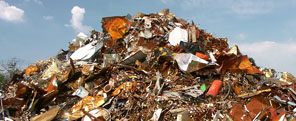|
Prevent Metal Corrosion
A walk through an abandoned junk yard provides a compelling demonstration of the destructive power of corrosion. Unfortunately, it is possible to observe this same deteriorating force at work in any machine shop, if the proper rust preventives are not used.
Metal corrosion is an electrochemical reaction between metal and the environment. It can be uniform across the metal surface, or localized, as in pitting. An estimated $300 billion per year is lost by U.S. Industry due to its effects, which include scrap, reduced tool and component life, damage to machinery, downtime, lost sales, and other factors.
The elements essential to the formation of metal corrosion are oxygen, water, and a susceptible surface. Different metals corrode in different ways. Aluminum forms a passivating corrosion layer, (barrier oxide film) which blocks oxygen from causing additional damage. This gives aluminum the appearance of being corrosion resistant. While this type of corrosion is beneficial, ferrous metal corrosion is by nature, destructive. Ferrous metals contain iron and are susceptible to red rust, a type of corrosion which is porous to oxygen. It commonly occurs after machining or grinding operations.
Rust preventives protect metals by keeping water and oxygen away from metal. Using organic polar molecules that have a negative polar charge capable of adhering to metal in a tight surface pattern, rust preventives leave a residual film that blocks oxygen from causing metal corrosion.
In a machine shop or factory, conditions that promote metal corrosion include:
- High heat and humidity.
- Acidic fumes from concurrent plant operations.
- Improper machine tool grounding.
- Contact between wet components.
- The use of hard water to dilute metalworking fluids.
- Metalworking fluid pH levels that are too low.
- High particulate content in metalworking fluid.
Preventing metal corrosion is one of the most important things a shop owner can do to keep parts quality high, and machinery running at peak efficiency. When it's done well, it also pays important benefits in keeping overall shop costs under control.
NEXT ESSAY
 |
|
Need More Information?
Acculube has extensive knowledge about preventing corrosion in a metalworking environment, and can help you determine the best rust preventives for
your operations.
Contact Us: 1.800.404.2570 or email us at sales@acculube.com
|
|


